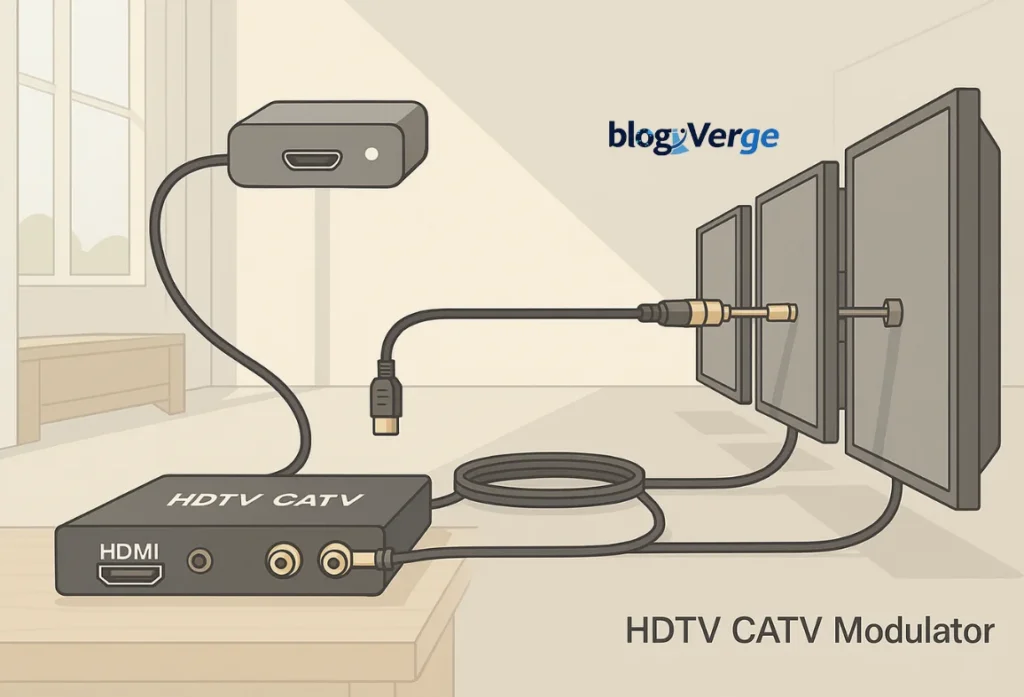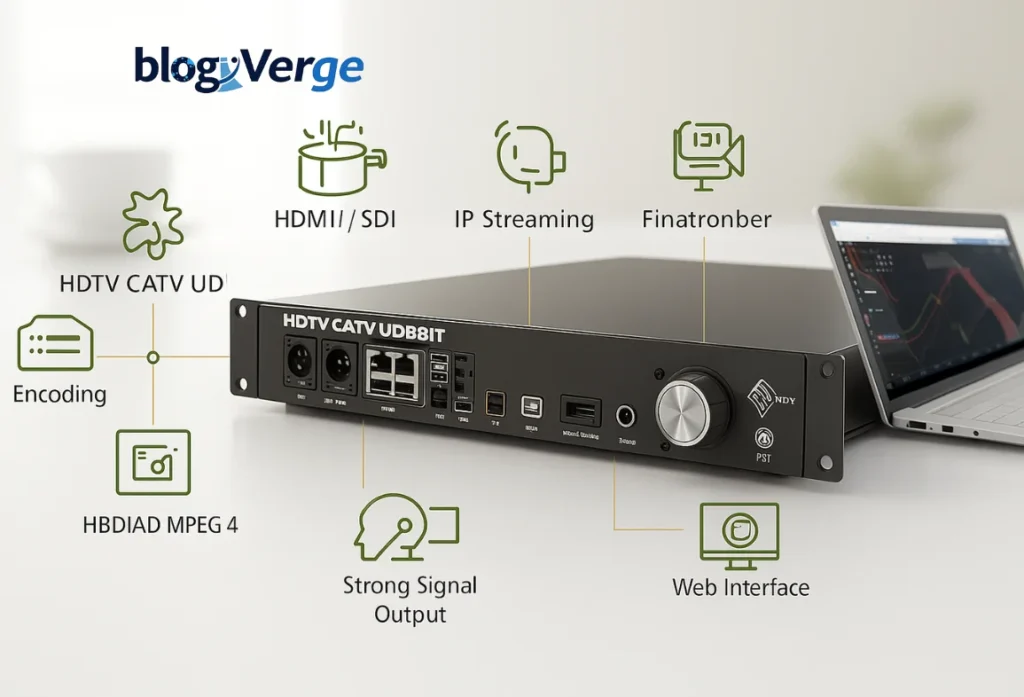In the globalized world that we live in, HD video is ubiquitous, found in hotel rooms, hospitals, campuses, and even massive mansions. However, the point is that it is not always convenient to deliver that HD content to multiple television sets. It is then that the HDTV CATV modulator comes in. It is the silent companion of smooth HD video transmission on the existing coaxial cables.
Now, how it really works, why it is essential, and how you can make the best out of it.
Table of Contents
What Is an HDTV CATV Modulator?
Imagine the HDTV CATV modulator as a connector between your HD source (which can be HDMI, media player or streaming box) today and your local coaxial TV networks.
It converts it to a digital video stream typically HDMI), then encodes it to a standard format and transmits it to a particular RF channel. That can be passed then via coax cable to any regular TV in the building.
The way it works, in simple terms, is as follows:
- Input: HDMI or any other HD is plugged in.
- Encoding: The modulator explodes and prepares the signal.
- Modulation: It allocates the video to a video frequency (such as Ch. 10 or Ch. 15).
- Output: The signal is sent through coax to the TVs that are connected.
Instead of having to have several HDMI cables or streams of boxes, a single device will deliver the quality video to all the televisions effectively and reliably.

Why are you supposed to use an HDTV CATV Modulator?
This is the fact that is likely to make you have a coaxial cable in your building. Why not use it?
HDTV CATV modulator saves time, money and inconvenience. Here’s why it’s worth it:
1. Rides on existing infrastructure.
There is no need to rewire and install HDMI everywhere. You can utilize the coax network that you have.
2. Central Control
Operate your channels through a single location. PIM Contents can be updated or switched immediately.
3. Broadcast-Style Simplicity
Every smart TV has to tune to a channel number – no apps or logging in.
4. Flexible Standards
Most HDTV CATV modulators support all of them regardless of whether you are using QAM, ATSC, or DVB-T.
5. Cost-Effective
Rather than two or more set-top boxes or media players, a single modulator is required on each channel.
6. Reliable and Scalable
When you add a channel, you do not need to rewire it, and you can add many channels until you require them.
👉 Watch this quick demo: [How to Set Up an HDTV CATV Modulator]
Key Features to Look For
A HDTV CATV modulator: select what matches your system:
Types of input: HDMI, SDI or IP stream.
Resolution: 1080p minimum; 4K will be an added advantage.
Encoding: The H.264 or MPEG-2 should be found compatible.
Output power: The greater dBmV is, the stronger and cleaner the signals are.
Web interface: Remote management.
These features make sure your modulator runs smoothly and integrates well with your TVs and network.

Real-World Uses
This is where you will actually find modulators having a difference:
Hotels & Resorts
Show welcome messages, event schedule and local information on specially designed channels.
Apartment Complexes
Announcements of share building, coax CCTV feeds or community updates.
Schools & Campuses
Broadcast lessons or news on several television sets and stages.
Corporate Offices & Hospitals.
Deliver in-house information, training videos or emergency alerts in real time.
Installation Basics
Installing an HDTV CATV modulator is not that difficult as long as you know how to lay everything out:
1. Make a connection between the modulator and the HDMI source.
2. Get the channels a frequency that does not intersect with existing ones.
3. Right to your coax distribution network.
4. Switch on your televisions to the designated stations.
5. Signal quality and strength- test and adjust.
That’s it. After this is set in place, you will have a high-definition signal on all the screens.
Why It Matters
The magic behind an HDTV CATV modulator is the ability to combine the latest HD content and an older infrastructure. You do not need to change cables, purchase additional devices, or use complicated network streaming.
It is scalable, robust, and lasts long with only a plug.
Conclusion
Then, here is the point: if you want to share an HD video with several TVs without laying miles of new cable and using streaming boxes, an HDTV CATV modulator is what you are looking for.
It converts the modern HDMI sources to the traditional coax networks, making it easy, scalable and reliable. It saves time, helps minimize clutter, and provides crystal-clear video in every place you desire it, whether it is a hotel, school, corporate facility or a large home.
The fact is that when you have installed one, you will wonder why you did not install it before. It is the simplest method of getting your coax network a professional-grade HD distribution system without the need to purchase two or three powerful boxes.
FAQs
Q1: An HDTV CATV modulator.
Ans: It converts the HDMI or HD video into a coax signal, which can be utilized in the distribution of TV.
Q2: Can I use it with any TV?
Ans: No, provided that the TV has a coax input and a tuner.
Q3: Is it hard to install?
Ans: Not really. The majority of people can do this themselves through mere setup procedures.
Q4: Does it support 4K?
Ans: Yes, there are higher models, but 1080p is the standard of these models.

